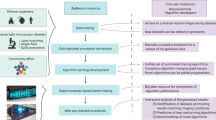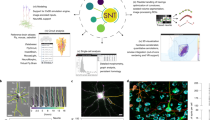Abstract
We report webKnossos, an in-browser annotation tool for 3D electron microscopic data. webKnossos provides flight mode, a single-view egocentric reconstruction method enabling trained annotator crowds to reconstruct at a speed of 1.5 ± 0.6 mm/h for axons and 2.1 ± 0.9 mm/h for dendrites in 3D electron microscopic data from mammalian cortex. webKnossos accelerates neurite reconstruction for connectomics by 4- to 13-fold compared with current state-of-the-art tools, thus extending the range of connectomes that can realistically be mapped in the future.
This is a preview of subscription content, access via your institution
Access options
Access Nature and 54 other Nature Portfolio journals
Get Nature+, our best-value online-access subscription
$29.99 / 30 days
cancel any time
Subscribe to this journal
Receive 12 print issues and online access
$259.00 per year
only $21.58 per issue
Buy this article
- Purchase on Springer Link
- Instant access to full article PDF
Prices may be subject to local taxes which are calculated during checkout


Similar content being viewed by others
References
Denk, W. & Horstmann, H. PLoS Biol. 2, e329 (2004).
Eberle, A.L. et al. J. Microsc. 259, 114–120 (2015).
Kasthuri, N. et al. Cell 162, 648–661 (2015).
Helmstaedter, M. Nat. Methods 10, 501–507 (2013).
Saalfeld, S., Cardona, A., Hartenstein, V. & Tomancak, P. Bioinformatics 25, 1984–1986 (2009).
Schneider-Mizell, C.M. et al. eLife 5, e12059 (2016).
Rasmussen, L. Lect. Notes Comput. Sci. 3579, 7 (2005).
Helmstaedter, M., Briggman, K.L. & Denk, W. Nat Neurosci 14, 1081–1088 (2011).
Wanner, A.A., Genoud, C. & Friedrich, R.W. Sci. Data 3, 160100 (2016).
Wanner, A.A., Genoud, C., Masudi, T., Siksou, L. & Friedrich, R.W. Nat. Neurosci. 19, 816–825 (2016).
Helmstaedter, M. et al. Nature 500, 168–174 (2013).
Berning, M., Boergens, K.M. & Helmstaedter, M. Neuron 87, 1193–1206 (2015).
Hua, Y., Laserstein, P. & Helmstaedter, M. Nat. Commun. 6, 7923 (2015).
Braitenberg, V. & Schüz, A. Anatomy of the cortex: statistics and geometry Vol. 18 (Springer Science & Business Media, 2013).
Narayanan, R.T. et al. Cereb. Cortex 25, 4450–4468 (2015).
Becker, C., Ali, K., Knott, G. & Fua, P. IEEE Trans. Med. Imaging 32, 1864–1877 (2013).
Kreshuk, A., Koethe, U., Pax, E., Bock, D.D. & Hamprecht, F.A. PLoS One 9, e87351 (2014).
Staffler, B. et al. Preprint at http://biorxiv.org/content/early/2017/01/22/099994 (2017).
Dorkenwald, S. et al. Nat. Methods 14, 435–442 (2017).
Piegl, L. & Tiller, W. The NURBS book (Springer Science & Business Media, 2012).
Briggman, K.L., Helmstaedter, M. & Denk, W. Nature 471, 183–188 (2011).
Acknowledgements
We thank D.Y. Buckley, E. Klinger and P. Laserstein for helpful discussions and comments on the manuscript; C. Roome, F. Kaiser and C. Guggenberger for outstanding IT support; and J. Striebel, S. Mischkewitz, N. Ring, A. Motta, B. Staffler and M. Zauser for contributions to the code. We thank E. Arzt and A.M. Burgin for hosting KMB at the Instituto de Investigación en Biomedicina de Buenos Aires, Argentina. We thank J. Abramovich, D. Acay, M. Ali, S. Babl, A. Banschbach, N. Berghaus, D. Beyer, L. Bezzenberger, F. Bock, D. Boehm, A. Budco, L. Buxmann, D. Celik, H. Charif, N. Cipta, T. Decker, J. Depnering, V. Dienst, S. Dittmer, L. Dufter, J.E. Martinez, H. Feddersen, A. Feiler, L. Feist, L. Frey, K. Friedl, A. Gaebelein, L. Geiser, D. Greco, M. Groothuis, S. Gross, A. Haeusl, S. Hain, J. Hartel, M.-L. Harwardt, B. Heftrich, M. Helbig, J. Heller, S. Hermann, J. Hoeltke, T. Hoermann, M. Hofweber, R. Huelse, R. Jakob, R. Jakoby, R. Janssen, M. Karabel, S. Kempf, L. Kirchner, J. Knauer, R. Kneissl, T. Koecke, P. Koenig, M. Kolodziej, F. Kraemer, E. Kuendiger, D. Kurt, M. Kuschnereit, E. Laube, D. Laubender, M. Lehnardt, Irene Meindl, Iris Meindl, J. Meyer, P. Mueller, N. Neupaertl, M. Perschke, M. Poltermann, M. Praeve, K. Puechler, M. Reiner, T. Reimann, V. Robl, F. Ruecker, T. Ruff, F. Sahin, D. Scheliu, V. Schuhbeck, S. Seiler, I. Stasiuk, B. Stiehl, A. Strubel, R. Thieleking, K. Trares, P. Wagner, Y. Wang, J. Wastl, A. Weber, S.S. Wehrheim, C. Weiss, M. Werr, A. Weyh, and J. Wiederspohn for annotation work.
Author information
Authors and Affiliations
Contributions
M.H. initiated and supervised the project; K.M.B., M.B., T.B., N.R., T.W. and M.H. developed specifications and conceptual design with contributions by H.W.; T.B., D.B., J.F., T.H., P.O., N.R., T.W., D.W., G.W. and K.M.B. implemented the software; H.W., M.B., K.M.B. and F.D. provided data; K.M.B., M.H., H.W. and M.B. analyzed the data; M.H., K.M.B. and M.B. wrote the manuscript with contributions by all authors.
Corresponding authors
Ethics declarations
Competing interests
T.B., T.H. and N.R. own scalable minds UG (haftungsbeschränkt) & Co. KG, which offers IT consulting services–among these, the installation and usage of webKnossos. D.B., J.F., P.O., D.W. and G.W. are employees of this company. T.W. is a former employee and does not hold any shares of this company. All other authors declare no competing financial interests.
Integrated supplementary information
Supplementary Figure 1 Annotator training, neurite length measurement and skeleton consolidation.
(a) Tracing speed per annotator during training for flight mode (magenta) and ortho mode (black) tracings (average data shown in Fig. 1h) (b) User-preset maximum movement speed per annotator during training for flight mode (magenta) and ortho mode (black). (c) Tracing speed per annotator during test reconstruction in flight mode (magenta) and ortho mode (black) (average data shown in Fig. 1i) (d) User-preset maximum movement speed per annotator during test tracing in flight mode (magenta) and ortho mode (black). (e) Histogram of total previous tracing experience of all annotators in training experiment (Fig. 1h). (f) Skeleton path length measurement examples: axon traced in ortho (black) and flight (magenta); magnification in f2a shows higher skeleton node density for flight-traced aonxs; f3 and f4 show comparison of skeletons smoothed using NURBS of node order 4 (NO 4, dotted) and variable node order (NO var, dashed). See Methods for details. Scale bars apply to f1..f4 (from top to bottom). (g) Comparison of path length measurements for 10 axons traced in ortho and flight mode. For calibration of optimal path length measurement, the average of 7 to 21 tracings per axon was used. Note that variable NO method renders measurements in ortho and flight mode similar to about 2% path length variability; and all path length measurement methods vary by no more than about 15-20%. See Methods for details. (h) Vote histogram from RESCOP algorithm (Helmstaedter et al., 2011) based on ortho tracings published in (Hua et al., 2015), ortho and flight tracings from the training experiment (Fig. 1h), respectively (see (Helmstaedter et al., 2011) for details); total vs. agreeing votes. (i) Decision error perr(T,N) for same data, with optimum (white dotted line) and majority vote (black dashed line) decision threshold, see Methods and (Helmstaedter et al., 2011). Cited references: Helmstaedter et al. (2011) NatNeurosci 14:1081. Hua et al. (2015) Nat Commun 6:7923.
Supplementary Figure 2 Spine and synapse detection for connectome mapping.
(a) Spine attachment procedure: histogram of average distance to closest dendrite dpd as used for spine attachment (n = 200, training data). The mean distance of the last three nodes to the closest dendrite shaft is calculated (grey lines in inset). Gray dashed line, threshold dpd* chosen as attachment threshold (see Methods). (b) Fraction of total annotation time spent on synapse annotation for varying volume density of dendrites and axons. Dashed lines indicate dense regime in which the potential innervation surround of 5 μm radius around axons or dendrites is volume-filling (see Methods). Magenta line indicates regime in which axon-focused synapse annotation is more efficient than dendrite-focused synapse annotation (see Methods and Fig. 2a-c). Grey line in colorbar indicates maximum fraction of synapse annotation time in the case of dense reconstructions. Arrow: fraction of synapse annotation time for connectome shown in Fig 2d-e (circle); example L4-to-L2/3 connectome shown in Fig. 2c: cross.
Supplementary information
Supplementary Text and Figures
Supplementary Figures 1–2
Supplementary Software 1
MATLAB code for automated detection of open branch points and first nodes with degree 1 in skeleton reconstructions (Fig. 1k-n, see Methods page 11, see detectopenBP.m). MATLAB code for measurement of skeleton path length and skeleton path smoothing using NURBS (Fig. 1 h-o, Suppl. Fig. 1 f-g, see pathLengthNURBS.m). MATLAB code for preparing axon skeletons for flight mode synapse annotation (see Methods page 16, see linearizeSkeletons.m). MATLAB scripts to attach spine annotations to dendrite tracings and for evaluating spine attachment performance (Fig. 2 a-b, Suppl. Fig. 2a, see attachSpines.m). Note these scripts require the skeleton data in Supplementary Software 2 and 3
Supplementary Software 2
Skeleton data for scripts in Supplementary Software 1; part 1
Supplementary Software 3
Skeleton data for scripts in Supplementary Software 1; part 2
Supplementary Software 4
Python library for interfacing with the webKnossos API for measuring task completion times and automate task and project creation (for randomized assignment of tracing tasks to annotators, Fig. 1 h-o)
Supplementary Software 5
All code and installation instructions for installing webKnossos independently on a web server. The source code is licensed under AGPLv3. The code is also available as a public GitHub repository at https://github.com/scalableminds/webknossos upon publication.
webKnossos Flight mode example, Expert tracing; Axon in Cortex; average speed: 1.7 mm/h
Video demonstrating flight mode, including the creation and annotation of branchpoints. Note that the annotator encounters a branch point at 12”, inspects this location briefly, then presses “b” for branch point creation at 18”, and jumps back to this location after reaching the end of the dataset at 44”.
Brief instruction for testing webKnossos
Brief introductory video for using the webKnossos demo site at https://demo.webknossos.brain.mpg.de
Source data
Rights and permissions
About this article
Cite this article
Boergens, K., Berning, M., Bocklisch, T. et al. webKnossos: efficient online 3D data annotation for connectomics. Nat Methods 14, 691–694 (2017). https://doi.org/10.1038/nmeth.4331
Received:
Accepted:
Published:
Issue Date:
DOI: https://doi.org/10.1038/nmeth.4331
This article is cited by
-
Whole-body cellular mapping in mouse using standard IgG antibodies
Nature Biotechnology (2024)
-
Building an automated three-dimensional flight agent for neural network reconstruction
Nature Methods (2024)
-
RoboEM: automated 3D flight tracing for synaptic-resolution connectomics
Nature Methods (2024)
-
High-contrast en bloc staining of mouse whole-brain and human brain samples for EM-based connectomics
Nature Methods (2023)
-
Imaging brain tissue architecture across millimeter to nanometer scales
Nature Biotechnology (2023)



